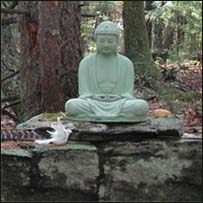|
|
 |
Please support Dharma Seed with a 2025 year-end gift.
Your donations allow us to offer these teachings online to all.

|

|

|
The greatest gift is the
gift of the teachings
|
|

|
| |
|
Dharma Talks
|
2016-04-24
Equanimity: Finding Balance in Our Practice
2:55:56
|
|
James Baraz
|
|
|
This daylong includes general talks on the theme of cultivating equanimity into your dharma practice. In addition to the talks and discussion, I offer the following practices with instructions that can be used to incline the mind toward equanimity (edited to remove lengthy periods of silence during the guided meditations):
Practice #1 - Seeing things as they are
Practice #2 - Looking through the lens of impermanence
Practice #3 - Looking through the lens of vedana
(feeling tone; 2nd foundation of mindfulness)
Practice #4 - Equanimity with Big Mind meditation
Practice #5 - Equanimty using traditional Brahma Viharas phrases
|
|
Insight Meditation Community of Berkeley
:
IMCB Regular Talks
|
|
|
2016-04-14
Seven Factors of Awakening
9:07:51
|
|
| with
Ayya Sobhana,
Chris Clifford,
Daniel Bowling,
Fa Jun,
Janetti Marotta,
Margaret Gainer,
Misha Merrill,
Oren Jay Sofer,
Sean Oakes,
Shaila Catherine,
Sharon Allen
|
|
These seven qualities offer an effective framework for cultivating the mind, overcoming the hindrances, and balancing the energetic and calming forces that develop in meditation. When cultivated and balanced, the mind is ripe for awakening. This series will explore each factor to reveal its importance, function, and role in the process of awakening.
|
|
Insight Meditation South Bay - Silicon Valley
|
|
|
|
|
2016-04-13
Meditation - Vipassana - Practice of Seeing Clearly
18:38
|
|
Tara Brach
|
|
|
Vipassana, also known as insight meditation, is training in bringing a clear mindful attention to our moment to moment experience. We begin by relaxing through the body and then resting attention with the breath - or some other sensory anchor - and allowing the mind to settle. Then we open to whatever is predominant or calling our attention - sensations, emotions, sounds - meeting each arising experience with a clear, kind attention. The gift of this process is discovering balance in the midst of the changing flow, and gaining deep insight into the nature of reality.
|
|
Insight Meditation Community of Washington DC
:
IMCW Wednesday Evening Talks
|
|
|
2016-04-12
Thus Have I Heard
5:01:05
|
|
| with
Andrea Fella,
Diana Clark,
Kim Allen,
Nona Olivia,
Sean Oakes,
Shaila Catherine,
Tony Bernhard
|
|
The Pali Canon includes over 5,000 discourses that document conversations and encounters that occurred during forty years of the Buddha's ministry. Over the centuries, certain teachings have risen to the surface with popularity and come to characterize our impression of what the Buddha taught. However, the vast collection of source material reaches beyond these well known teachings. For this speaker series, IMSB has invited teachers to focus on teachings that have been largely neglected by contemporary Buddhist groups. Each talk will share a lesser-known teaching, event, or instruction that will enrich our comprehension of what the Buddha taught. We will discover whether broadening our source material reinforces the dominant view of Buddhist practice or paints a different picture of meditation and the path of liberation.
|
|
Insight Meditation South Bay - Silicon Valley
|
|
|
|
|
2016-04-06
Patience and Equanimity
58:45
|
|
Sally Armstrong
|
|
|
Patience and equanimity are two of the paramis - 10 perfections that we develop in our practice on the path to awakening. Ledi Sayadaw says that “Patience and equanimity are the mainstay for the perfections. Only when one has set oneself up in these two can one expect to fulfill the rest." These 2 qualities are intertwined and support each other: if we are patient, we are developing equanimity, and vice versa. Both are necessary for our meditation practice and bring peace and calm into our minds and hearts.
|
|
Spirit Rock Meditation Center
:
Equanimity: Seeing with Quiet Eyes
|
|
|
|
|